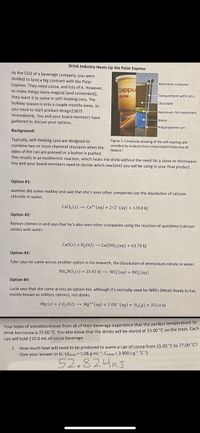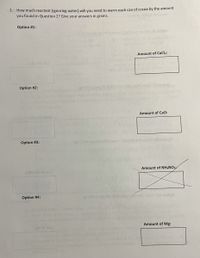
Chemistry
10th Edition
ISBN: 9781305957404
Author: Steven S. Zumdahl, Susan A. Zumdahl, Donald J. DeCoste
Publisher: Cengage Learning
expand_more
expand_more
format_list_bulleted
Question
I need help with question three. I provided the information and also the answer to question 2, which I got 52.824kJ. On question three I just need option: 1,2,&4.

Transcribed Image Text:Drink Industry Heats Up the Polar Express
As the CEO of a beverage company, you were
thrilled to land a big contract with the Polar
Express. They need cocoa, and lots of it. However,
Aluminum container
to make things more magical (and convenient),
they want it to come in self-heating cans. The
Cappu
dente
Compartment with CaCl,
Chocolate
holiday season is only a couple months away, so
you need to start product design23875
immediately. You and your board members have
gathered to discuss your options.
Aluminum foil membrane
3scaute
Water
Polypropylene can
Background:
Typically, self-heating cans are designed to
combine two or more chemical reactants when the
sides of the can are pressed or a button is pushed.
This results in an exothermic reaction, which heats the drink without the need for a stove or microwave.
You and your board members need to decide which reactants you will be using in your final product.
Figure 1: Composite drawing of the self-heating unit
provided by students from Universidad Politécnica de
Madrid.
Option #1:
Jasmine did some reading and said that she's seen other companies use the dissolution of calcium
chloride in water.
CaCl, (s) - Ca²+(aq) + 2 CI-(aq) + 120.0 kJ
Option #2:
Ramon chimes in and says that he's also seen other companies using the reaction of quicklime (calcium
oxide) with water.
Ca0(s) + H20(!) → Ca(OH)2(aq) + 63.70 kJ
Option #3:
Tyler says he came across another option in his research, the dissolution of ammonium nitrate in water.
NH, NO, (s) + 25.41 kJ → NH (aq) + NO5 (aq)
Option #4:
Lucia says that she came across an option to0, although it's normally used for MRES (Meals Ready to Eat,
mostly known as military rations), not drinks.
Mg (s) + 2 H20(1) → Mg²*(aq) + 2 OH (aq) + H2(g) + 351.0 kJ
Your team of scientists knows from all of their beverage experience that the perfect temperature to
drink hot cocoa is 77.00 °C. You also know that the drinks will be stored at 15.00 °C on the train. Each
can will hold 210.0 ml of cocoa beverage.
2. How much heat will need to be produced to warm a can of cocoa from 15.00 °C to 77.00 °C?
Give your answer in kJ. (dcocoa = 1.06 g mL-1; Ccocoa = 3.900 Jg1 °c)
52.824KJ
toxs no

Transcribed Image Text:3. How much reactant (ignoring water) will you need to warm each can of cocoa by the amount
you found in Question 2? Give your answers in grams.
Option #1:
Amount of CaCl2:
Option #2:
widh
Amount of CaO:
Option #3:
Amount of NH,NO3;
Option #4:
Amount of Mg:
Expert Solution
This question has been solved!
Explore an expertly crafted, step-by-step solution for a thorough understanding of key concepts.
This is a popular solution
Trending nowThis is a popular solution!
Step by stepSolved in 6 steps

Knowledge Booster
Learn more about
Need a deep-dive on the concept behind this application? Look no further. Learn more about this topic, chemistry and related others by exploring similar questions and additional content below.Similar questions
- When 5.88 g of copper is heated from 17.6℃ to 485.0℃, what is the value of q? The specific heat capacity for copper is: Cs,Cu = 0.387 J/g℃. (Caution, watch units!) Select one: a. + 2.61 x 10^3 kJ b. + 1.06 kJ c. + 467 kJ d. +181 J e. + 1.06 x 10^3 kJ f. – 467 kJ g. None of these h. – 15.5 J i. – 52.1 kJ j. + 15.5 Jarrow_forwardThe following are equations of interest in a laboratory similar to your current exercise. Your goal is to find the enthalpy change (deltaH) for reaction 1. Mg(s) + 1/2O2(g) --> MgO(s) deltaH1 = ? Mg(s) + 2H+(aq) --> Mg2+(aq) + H2(g) deltaH2 = +10.1 kJ/mol MgO(s) + 2H+(aq) --> Mg2+(aq) + H2O(l) deltaH3 = -5.0 kJ/mol 1/2O2(g) + H2(g) --> H2O(l) deltaH4 = -286.0 KJ/mol To arrive at equation 1 from the others... match the following equations with what you would need to do in order to add up properly to equation 1. You will also be asked to calculate the deltaH1 in an upcoming question. (hint: write it out on scrap paper, signs change if an equation is reversed.)arrow_forwardPlease help me, double and triple check your answers previous tutors got it wrong,arrow_forward
- BE’s are: C=O 799, C–H 413, O–H 467, O–O 498, H–H 432 kJ/mol CO2(g) + 4H2(g) → CH4(g) + 2H2O(g) ΔHrxn° = ___ kJ (from ΔHf°s) ΔHrxn°(BE) = ___ kJ (from BEs) = (2x799+432-4x413-4x467) CH4(g) + 2O2(g) → CO2(g) + 2H2O(g) ΔHrxn° = ___ kJ (from ΔHf°s) ΔHrxn°(BE) = ___ kJ (from BEs) ...Calculate ΔHrxn°s from both!arrow_forwardand 2 Enthalpy #1.30 enoindice pled TT 2010 2D49.bs 22) When 1 mole of Fe2O3(s) reacts with H₂(g) to form Fe(s) and H2O(g) according to the following equation, 98.8 kJ of energy are absorbed. (6 Fe2O3(s) + 3 H2(g) → 2 Fe(s) + 3 H₂O(g) (pp) (20/d4 (pm) $40 D Reaclanis 13:48 SH Products endothermic, A endothermic, B (2) exothermic, A exothermic, B nad W (21 Enthalpy MOMS. Reactants Products (A) (B) Is the reaction endothermic or exothermic, and which of the enthalpy diagrams above represents grow olor and to noin (01 this reaction? SH GH TH A HOMH X HILD 08.10 Page 6 of 8arrow_forwards_engine.html?ClassID=824851601# The calorimeter begins at the same temperature as the water, 22.0 °C and warms to the same temperature as the water, 62.7 °C. The heat capacity of the calorimeter is 9.3 J/°C. What is the heat change for the calorimeter? ¶Cal = [?]J %3D Enter either a + or - sign AND the magnitude. q,cal (J) Enterarrow_forward
- (Q5) Consider an endothermic reaction that takes place in 553 mL of solution. If the reaction requires 4,380 J of energy and the initial temperature of the solution is 26.2, what will the final solution temperature be? (3 sf) The density of solution is 1.00 g/mL and the specific heat of the solution is the same as that of water.arrow_forwarda system does 596 kJ of work and loses 276 kJ of heat to the surroundings. What is the change in internal energy, E, of the system? Not that the internal energy is symbolized as U in some sources. E= _______ kJarrow_forwardHow do we get the answers (in blue) to this question?arrow_forward
arrow_back_ios
arrow_forward_ios
Recommended textbooks for you
 ChemistryChemistryISBN:9781305957404Author:Steven S. Zumdahl, Susan A. Zumdahl, Donald J. DeCostePublisher:Cengage Learning
ChemistryChemistryISBN:9781305957404Author:Steven S. Zumdahl, Susan A. Zumdahl, Donald J. DeCostePublisher:Cengage Learning ChemistryChemistryISBN:9781259911156Author:Raymond Chang Dr., Jason Overby ProfessorPublisher:McGraw-Hill Education
ChemistryChemistryISBN:9781259911156Author:Raymond Chang Dr., Jason Overby ProfessorPublisher:McGraw-Hill Education Principles of Instrumental AnalysisChemistryISBN:9781305577213Author:Douglas A. Skoog, F. James Holler, Stanley R. CrouchPublisher:Cengage Learning
Principles of Instrumental AnalysisChemistryISBN:9781305577213Author:Douglas A. Skoog, F. James Holler, Stanley R. CrouchPublisher:Cengage Learning Organic ChemistryChemistryISBN:9780078021558Author:Janice Gorzynski Smith Dr.Publisher:McGraw-Hill Education
Organic ChemistryChemistryISBN:9780078021558Author:Janice Gorzynski Smith Dr.Publisher:McGraw-Hill Education Chemistry: Principles and ReactionsChemistryISBN:9781305079373Author:William L. Masterton, Cecile N. HurleyPublisher:Cengage Learning
Chemistry: Principles and ReactionsChemistryISBN:9781305079373Author:William L. Masterton, Cecile N. HurleyPublisher:Cengage Learning Elementary Principles of Chemical Processes, Bind...ChemistryISBN:9781118431221Author:Richard M. Felder, Ronald W. Rousseau, Lisa G. BullardPublisher:WILEY
Elementary Principles of Chemical Processes, Bind...ChemistryISBN:9781118431221Author:Richard M. Felder, Ronald W. Rousseau, Lisa G. BullardPublisher:WILEY

Chemistry
Chemistry
ISBN:9781305957404
Author:Steven S. Zumdahl, Susan A. Zumdahl, Donald J. DeCoste
Publisher:Cengage Learning

Chemistry
Chemistry
ISBN:9781259911156
Author:Raymond Chang Dr., Jason Overby Professor
Publisher:McGraw-Hill Education

Principles of Instrumental Analysis
Chemistry
ISBN:9781305577213
Author:Douglas A. Skoog, F. James Holler, Stanley R. Crouch
Publisher:Cengage Learning

Organic Chemistry
Chemistry
ISBN:9780078021558
Author:Janice Gorzynski Smith Dr.
Publisher:McGraw-Hill Education

Chemistry: Principles and Reactions
Chemistry
ISBN:9781305079373
Author:William L. Masterton, Cecile N. Hurley
Publisher:Cengage Learning

Elementary Principles of Chemical Processes, Bind...
Chemistry
ISBN:9781118431221
Author:Richard M. Felder, Ronald W. Rousseau, Lisa G. Bullard
Publisher:WILEY